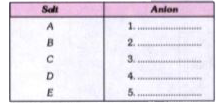When hydrogen is passed over a black solid compound A, the products are 'a colourless liquid' and 'a reddish brown metal B.' Substance B is divided into two parts, each placed in separate test tubes. Dilute HCl is added to one part of substance B and dilute HNO, to the other.
Is there any reaction between substance B and dilute hydrochloric acid ? Give reasons for your answer.
Step by step video & image solution for When hydrogen is passed over a black solid compound A, the products are 'a colourless liquid' and 'a reddish brown metal B.' Substance B is divided into two parts, each placed in separate test tubes. Dilute HCl is added to one part of substance B and dilute HNO, to the other. Is there any reaction between substance B and dilute hydrochloric acid ? Give reasons for your answer. by Chemistry experts to help you in doubts & scoring excellent marks in Class 9 exams.
Updated on:21/07/2023Topper's Solved these Questions
- STUDY OF THE FIRST ELEMENT - HYDROGENBOOK - ICSECHAPTER - STUDY OF THE FIRST ELEMENT - HYDROGENEXERCISE - EXERCISE 6(D)
48 Videos
- STUDY OF THE FIRST ELEMENT - HYDROGENBOOK - ICSECHAPTER - STUDY OF THE FIRST ELEMENT - HYDROGENEXERCISE - TOPIC 1 Hydrogen and its Laboratory Preparation (1 MARK QUESTIONS)
13 Videos
- STUDY OF THE FIRST ELEMENT - HYDROGENBOOK - ICSECHAPTER - STUDY OF THE FIRST ELEMENT - HYDROGENEXERCISE - EXERCISE 6(B)
29 Videos
- STUDY OF GAS LAWS BOOK - ICSECHAPTER - STUDY OF GAS LAWS EXERCISE - TOPIC 2 (5 Marks Questions )
18 Videos
- THE LANGUAGE OF CHEMISTRYBOOK - ICSECHAPTER - THE LANGUAGE OF CHEMISTRYEXERCISE - EXCERCISE 1(C ) (Correct the following statement)
21 Videos
Similar Questions
When hydrogen is passed over a black solid compound A, the products are .a colourless liquid. and .a reddish brown metal B..
Substance B is divided into two parts, each placed in separate test tubes.
Dilute HCl is added to one part of substance B and dilute HNO3 to the other.
Is there any reaction between substance B and dilute hydrochloric acid ? Give reasons for your answer.
View SolutionWhen hydrogen is passed over a black solid compound A, the products are 'a colourless liquid' and 'a reddish brown metal B.' Substance B is divided into two parts, each placed in separate test tubes. Dilute HCl is added to one part of substance B and dilute HNO3, to the other.
Name the substances A and B.
View SolutionWhen hydrogen is passed over a black solid compound A, the products are 'a colourless liquid' and 'a reddish brown metal B.' Substance B is divided into two parts, each placed in separate test tubes. Dilute HCl is added to one part of substance B and dilute HNO, to the other.
Write an equation for the reaction between hydrogen and substance A.
View SolutionWhen hydrogen is passed over a black solid compound A, the products are 'a colourless liquid' and 'a reddish brown metal B.' Substance B is divided into two parts, each placed in separate test tubes. Dilute HCl is added to one part of substance B and dilute HNO, to the other.
What happens to substance A when it reacts with hydrogen ? Give reasons for your answer.
View SolutionWhen hydrogen is passed over a black solid compound A, the products are .a colourless liquid. and .a reddish brown metal B..
Substance B is divided into two parts, each placed in separate test tubes.
Dilute HCl is added to one part of substance B and dilute HNO3 to the other.
Give two tests for the colourless liquid formed in the experiment. What does it signifies ?
View SolutionBlue litmus solution is added to two test tubes A and B containing dilute HCl and NaOH solution respectively. In which test tube a color change will be observed? State the colour change and give its reason.
View SolutionIron filings and sulphur were mixed together and divided into two parts, 'A' and 'B'. Part 'A' was heated strongly while part 'B' was not heated. Dilute hydrochloric acid was added to both the parts and evolution of gas was seen in both the cases. How will you identify the gases evolved?
View SolutionSalts A, B, C, D and E undergo reactions (i) to (v) respectively. Identify the anion present in these salts on the basis of these reactions. Tabulate your answers in the format given below:
(i) When silver nitrate solution is added to a solution of A, a white precipitate, insoluble in dilute nitric acid, is formed.
(ii) Addition of dilute hydrochloric acid to B produces a gas which turns lead acetate paper black.
(iii) When a freshly prepared solution of ferrous sulphate is added to a solution of C and concentrated sulphuric acid is gently poured from the side of the test-tube, a brown ring is formed.
(iv) When dilute sulphuric acid is added to D a gas is produced which turns acidified potassium dichromate solution from orange to green.
(v) Addition of dilute hydrochloric acid to E produces an effervescence. The gas produced turns lime water milky but does not affect acidified potassium dichromate solution.

View SolutionIdentify the following substances :
A dilute acid B which does not normally give hydrogen when reacted with metals but does give a gas when it reacts with copper.
View SolutionAn queous solution of a substance gives a white precipitate on treating with dilute hydrochloric acid which dissolves on heating. When hydrogen sulphide is passed through the hot solution, a black precipitate is obtained. The substance is :
View Solution
